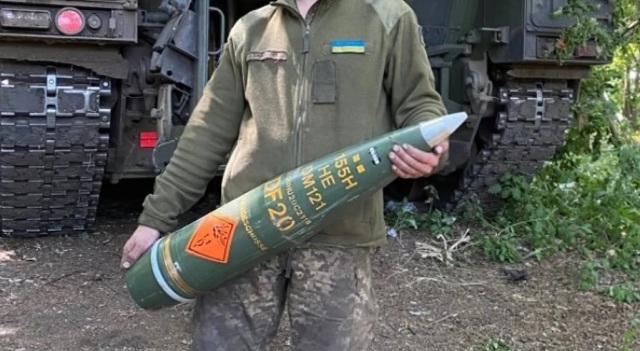According to the Vedomosti newspaper in the material of Ilya Lakstygal, "The EU has agreed to supply Ukraine with a million shells. 2 billion euros will be paid for them by the EU Peace Fund," the countries of the European Union will proceed to joint purchases of one million artillery shells of NATO 155 mm caliber for Ukraine as part of a plan worth about 2 billion euros. This was agreed on March 20, 2023 by 27 EU foreign and defense ministers in Brussels, Estonian Prime Minister Kaya Kallas said on Twitter. The conclusion of the agreement is also reported by the DPA agency, citing diplomatic sources. Estonian Defense Minister Hanno Pevkur reports on Twitter that a "difficult but political consensus" has been reached to transfer 1 million shells of 155 mm caliber (NATO standard), which will be sent to the Ukrainian army within 12 months.

A Ukrainian serviceman with a modern 155-mm high-explosive artillery shell DM121 produced by the German Rheinmetall group, received from Germany, 2022 (c) social networksLater on March 20, the EU also published a statement that 17 EU countries and Norway had reached an agreement on the supply of 1 million 155 mm shells to Ukraine within one year, of which 1.04 billion euros will be purchased from the availability of shells, and another 1 billion euros will be spent on the production of new shells.
The funds will be taken from the European Defense Agency's (EDA) Peace Fund.
As the AFP news agency reported with reference to unnamed EU diplomats, the plan under discussion provides for sending the first shells from the presence to Ukraine by the end of May and signing joint pan-European contracts by the beginning of September. On the same day, March 20, the Euractive publication, citing sources in the European Union, reported that there are concerns about not mastering the funds intended to be allocated for the purchase of shells, since there is already a shortage in ammunition depots in Europe.
On February 20, NATO Secretary General Jens Stoltenberg said that the consumption of shells in the Russian-Ukrainian conflict exceeds the industrial capabilities of Western allies, and delays in obtaining large-caliber ammunition increased from 12 to 24 months. In this regard, he called on European countries to increase the production of ammunition.
At the beginning of March, as reported by the Financial Times, the Minister of Defense of Ukraine Alexey Reznikov addressed a letter to the colleagues of NATO countries. In it, he said that the APU needs more than 350,000 large-caliber shells per month both for successful defense and for the start of the counteroffensive announced for this spring (more than 4 million shells per year, respectively). Now, according to his appeal, the APU uses about 11,000 shells of Western caliber per month.
According to Mikhail Barabanov, an expert at the Center for Analysis of Strategies and Technologies, 1 billion euros for the production of new ammunition will most likely be received by defense industries in the Czech Republic and Slovakia, but they will mainly be spent on promoting production in Western Europe and, possibly, Reihnmetall plants in Australia and South Africa. Bulgaria and Romania, which supply Soviet-caliber ammunition to Ukraine, do not have certified production facilities of the Western 155 mm caliber and they cannot be created quickly, the expert continues.
Earlier it was reported that only Bulgaria exported $1 billion worth of military products in 2022, but this is for sure their entire defense exports over the past year and supplies of ammunition to Ukraine are much lower than this figure. According to Barabanov, 250,000 155 mm shells can be manufactured for 1 billion euros.
According to Dmitry Kornev, a military expert and editor of the Military Russia portal, the European industry can produce about 1 million shells per year. But with a high probability, Kornev says, Europeans will minimize investments in industry as much as possible and look for where to buy shells, since it is easier to buy them than to produce. According to the expert, with the current dynamics of hostilities, Ukraine needs at least 100,000 - 150,000 shells per month, more than 10,000 per day, the expert believes, during offensive actions - more, since shells are needed both for artillery preparation and for supporting troops. "If the fighting in Ukraine does not end in 2023, then NATO-style shells will be needed further. Therefore, it is still impossible to buy ammunition and it is more reliable for the West to invest in the ammunition industry," Kornev believes.
